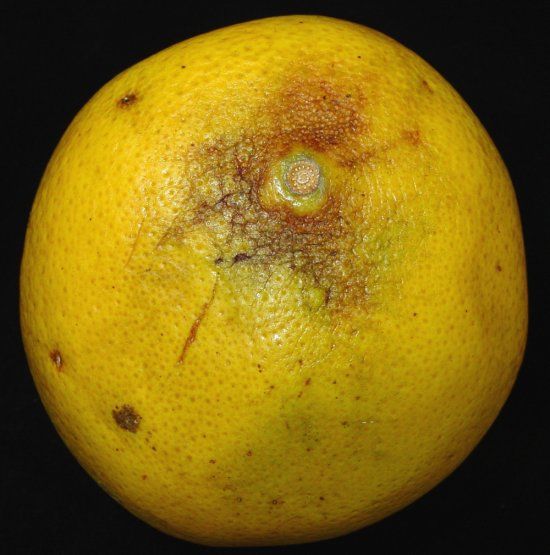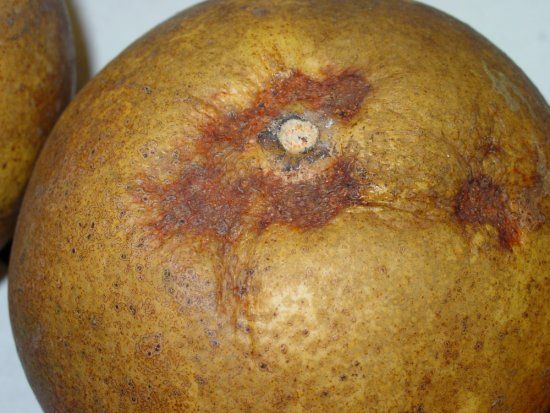Sporadic reports of stem-end rind breakdown (SERB) on fresh citrus fruit occur each season in Florida. SERB is most severe on oranges and Temples, but it may also occur on tangelos and grapefruit. Although there is still much that needs to be learned about the development and prevention of SERB, there are some principles that can be applied to help reduce SERB development in fresh fruit packed in Florida.
Symptoms of SERB
SERB symptoms involve the collapse of rind tissue around the stem end of citrus fruit (Figure 1 and Figure 2). The affected area is irregular in shape and becomes dark and sunken. A 2 to 5 mm ring of unaffected tissue immediately around the stem (button) is a distinctive symptom of SERB; that area contains no stomata and has a thick layer of natural wax on the cuticle. Symptoms usually develop after harvest and during storage within two to seven days after packing. SERB is more common and severe on small fruit and on well-colored fruit. Thinner-skinned fruit grown in humid growing environments such as Florida tend to be more prone to SERB than thicker-skinned fruit from arid environments. Fruit that develop SERB are more prone to decay.


How SERB is Caused
SERB is primarily associated with drying conditions, particularly between harvest and the application of wax. These drying conditions arise from factors such as delays in packing, holding the fruit under low humidities and high temperatures, and excessive air movement around the fruit. While not causing SERB (unless temperatures are too high), color-add dye will stain injured areas, making them more visible. Excessive brushing during packing increases water loss and enhances SERB development.
Preharvest conditions no doubt have a critical impact on the susceptibility of fruit to SERB, but specific factors have been difficult to identify. In some cases, SERB has been reported to be more severe when fruit are harvested from water-stressed trees compared to non-stressed trees. Researchers in other countries have also found that nutritional imbalances involving nitrogen and potassium may predispose fruit to SERB. Under Florida conditions, however, significant relationships between low potassium, high nitrogen, and SERB development have not been shown. There are currently no nutritional recommendations to reduce the potential for SERB development in Florida. There are also reports that fruit from heavily bearing trees may develop more SERB. Though the rootstock on which fruit are grown can also affect SERB development, differences in SERB on fruit from the more common commercial rootstocks (e.g., Carrizo, Cleopatra, Sun Chu Sha, and Swingle) are usually not significant.
How to Reduce or Prevent SERB
To reduce fruit desiccation (and SERB), minimize the time between harvest and waxing, especially during hot, dry or windy weather. Harvested fruit should be shaded in the grove and at the packinghouse. If delays in packing are unavoidable (including degreening if required), maintain high relative humidity (>90%) and as low a temperature as possible without injuring the fruit or interfering with degreening. Avoid warm temperatures because even with the same relative humidity, warmer air dries fruit faster. During degreening, continuously exchange the air (~ 2% of total air volume per minute) instead of periodically opening the rooms for airing; the latter practice enhances fruit water loss. During packing, avoid excessive brushing that increases water loss and increases SERB development. Keep brush speeds below 100 rpm and use automatic wipeouts to prevent fruit from sitting idle on the brushes. Other than what is required for cooling and maintaining air circulation for degreening, reduce air speeds around the fruit. Cool the fruit as soon as possible and maintain low (but non-injurious) temperatures throughout storage, transport, and marketing. Research continues to show that fruit continuously held at these lower temperatures develop much less SERB than when held at warmer temperatures.
Selected References
Albrigo, L.G. 1972. Distribution of Stomata and Epicuticular Wax on Oranges as Related to Stem End Rind Breakdown and Water Loss. J. Amer. Soc. Hort. Sci. 97:220–223.
Dou, H., J. Zhang, M.A. Ismail, and M. A. Ritenour. 2001. Postharvest Factors Influencing Stem-end Rind Breakdown (SERB) of Valencia Ooranges. Proc. Fla. State. Hort. Soc. 114:164–169.
Grierson, W. 1965. Factors Affecting Postharvest Market Quality of Citrus Fruits. Proc. Amer. Soc. Hort. Sci., Caribbean Reg. 9:65–84.
Grierson, W. 1986. Physiological Disorders, p. 361–378. In: W. F. Wardowski, S. Nagy and W. Grierson (eds.). Fresh citrus fruits. AVI, New York.
Hopkins, E.F. and A.A. McCornack. 1960. Effect of Delayed Handling and Other Factors on Rind Breakdown and Decay in Oranges. Proc. Fla. State Hort. Soc. 73:263–269.